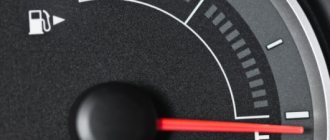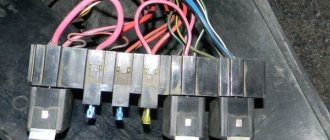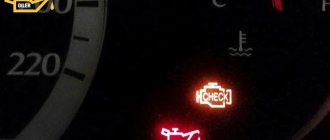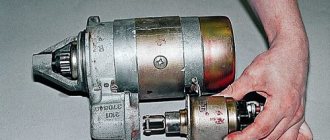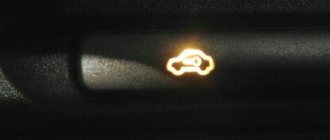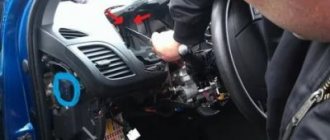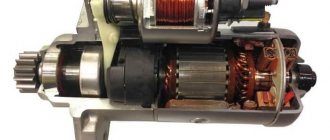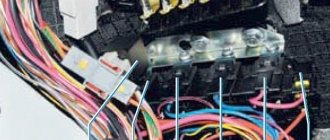More often starter does not turn over when hot due to the fact that when heated, the bushings expand slightly in size, which is why the starter shaft jams or does not rotate at all. Also, the reasons that the starter does not start when hot is the deterioration of electrical contacts in the heat, contamination of its internal cavity, violation of the contact group, and contamination of the “nickels”.
To troubleshoot, you need to get rid of the listed causes. However, there are a couple of “folk” methods with which even a worn starter can be made to rotate under significant heat.
| Cause of failure | What to do |
| Bushing wear | Replace |
| Deterioration of contacts | Clean, tighten, lubricate contacts |
| Reducing the insulation resistance of the stator/rotor winding | Check insulation resistance. Eliminated by replacing the winding |
| Contact plates in the solenoid relay | Clean or replace the “nickels” |
| Dirt and dust in the starter housing | Clean the internal cavity, rotor / stator / contacts / cover |
| Brush wear | Clean the brushes or replace the brush assembly |
Reasons why the starter does not turn hot
There are several reasons for the starter to fail to operate when the car engine is hot.
As car service experts note, the most “popular” of them is heating the bushing material from high temperature.
When heated, it, albeit slightly, still increases in size. As a result, the starter shaft is displaced, which interferes with its normal operation.
With a more significant expansion, the mechanism may jam. This defect can be eliminated by installing a new bushing.
In addition to this, there are other reasons why the starter does not turn over hot.
They are listed in the table, which also indicates options for eliminating this case.
| Cause of malfunction | Remedy |
| The resistance of the windings of the starter components: rotor or stator has decreased. | Using a multimeter, their value is checked. If the resistance is insufficient, the defective winding must be replaced. |
| Poor quality of contacts. | The conductive terminals are inspected. After which they are cleaned, adjusted, and lubricated. |
| Contamination of the internal space of the starter. | After dismantling the casing, the starter elements are cleaned from dust and dirt: the rotor, contact group, starter, and housing walls. |
| Natural wear or contamination of the solenoid relay contacts. | The contact pins are being cleaned and tightened. |
| Production of brushes. | Depending on the degree of the defect, they are cleaned and the starter brush assembly is partially or completely replaced. |
Also, one of the reasons for the starter to fail to operate on a hot engine is a faulty battery.
7 Best Car Calcium Batteries
You should check the voltage at the battery terminals. If the voltage does not meet the standard, you need to replace the used battery.
After eliminating the cause, the starter test should be performed on a working, fully charged battery.
Let us analyze the nature of the appearance of these defects.
As a rule, they happen on cars that have traveled a long distance.
1. Changing the size of the bushings. It occurs due to the natural wear of the part, as well as the not entirely correct installation of large bushings during a previous repair. The increased temperature causes the part to slightly expand, which leads to partial engagement of the rotor. This, in turn, negatively affects magnets.
2. Poor contact quality at elevated temperatures. The main reason for poor-quality contact is weakening of its fastening. As a result, in hot weather the terminals quickly burn out and may fail. Also, due to a weak connection, the current flowing through this area may decrease.
Other reasons for poor quality contacts: oxidation of the conductive sections of the wire connecting the starter and the ignition switch, poor-quality fixation of the negative battery wire going to the ground of the part. A group of contacts in a car's ignition switch can also cause a malfunction.
3. The nickels of the solenoid relay burn out. This reason is especially typical for classic car models of the Volzhsky Automobile Plant. Burning of contacts, dimes, and solenoid relays is a common occurrence for them. At elevated temperatures, this defect manifests itself even faster, and the quality of contact decreases.
4. Reducing the resistance of the rotor or stator windings from overheating. Increased temperature conditions help to reduce resistance, which in turn causes a decrease in EMF. As a result of this phenomenon, the starter begins to work unstably or may not spin at all.
5. Rotor contamination. Products of natural wear and tear of the brush assembly contaminate the rotor surface, thereby deteriorating the quality of contact.
DIY diagnostics and repairs
So, if the engine refuses to start when hot, you need to diagnose the starter unit. We will tell you more about how to check and repair the device below. The starter mechanism is an electric motor that starts working, receiving energy from the battery. One of the main characteristics of this unit is the consumption of high current at the moment of starting the internal combustion engine, but this only happens for a few seconds. And even then, thanks to the ability of the battery not to discharge.
If the unit does not work well when hot, but all units, mechanisms and circuits are operating normally, it is necessary to repair it. This procedure is not a simple one, so you need to have certain skills and knowledge. As a rule, this unit is mounted in the most inconvenient place for the car owner - at the bottom of the engine. For repairs, prepare standard tools, including a set of wrenches. For greater convenience, you will have to use an extended socket wrench (the author of the video about malfunctions, as well as detailed repairs of the device at home, is the Exin Plus channel).
In any case, you first need to dismantle the mechanism; this procedure is individual for each car, so we will not describe it. After the unit is removed, you need to disassemble its structure. If you do not want to encounter assembly problems after repair, then before disassembling the structure, make the appropriate marks on the body.
When disassembling the mechanism, pay attention to the condition of the following elements:
- Nodes and contacts. If you notice that there is a bad contact somewhere, it needs to either be cleaned or replaced. In some cases, stripping can eliminate scorching or oxidation.
- Overrunning clutch or bendix, this component also needs to be carefully checked. Make sure that the component can continue to be used. If the Bendix splines are worn out, then it would be better to change it.
- Anchor. If this component fails, problems with the operation of the motor may occur. The armature is equipped with a commutator, which can burn out as a result of severe wear of the brushes. In addition, no burning of any kind is allowed on the collector, and the same applies to blue plates. At the same stage, the integrity of the windings along with the insulation should be diagnosed.
Also, when this unit is disassembled, it will be necessary to carry out preventive maintenance of all components. All parts without exception must be cleaned of dirt and dust, as this may cause the unit as a whole to malfunction. In the event that the cause of interference in the operation of the mechanism is due to burnt contacts, they must be replaced; if the brushes are worn out or sticking, then you can try to repair them. If the repair does not produce results, then the brush assembly is replaced; for this, you can purchase a special repair kit at any automobile store. In the event that the mechanism simply cannot be repaired, it will need to be replaced with a functional one.
If the need for repairs causes you difficulties, it is better to seek help from specialists. Even if you pay money, you will be confident in the correctness of the actions performed and the functionality of the node.
Loading …
How to start the engine if the starter does not turn hot
To solve this problem, it is necessary to diagnose the starter.
To do this, you need to remove it from the car and follow these steps:
- Inspection of electrical contacts. You should check the condition of the wires and terminals, if necessary, clean them from oxidation and dirt, and tighten the fastenings. You also need to check the quality of the connection of the negative wire from the battery to the starter, the reliability of the wiring of the ignition switch and solenoid relay. Often the reason for a failure to operate may be an insufficient cross-section of the wires coming from the battery. Use a multimeter to check the voltage at the starter (the solenoid relay bolts). The arrow should show 13.5 V, no less.
- Checking the bushings. You need to inspect this part for wear and check for play. The change in size causes unstable rotor operation. When replacing used bushings with new ones, you should install parts whose dimensions are specified by the machine manufacturers.
- Monitoring the resistance readings of the stator and rotor windings. The test is carried out with a multimeter set to kilo-ohms. The device needle should not show a value below 3.5 - 10 kOhm. Otherwise, you will have to replace the winding or the part as a whole.
- Checking the condition of the rotor. If there is contamination, you need to clean the surface using a compressor, then a brush and sandpaper (No. 400, 800).
- Inspection of the "pyataks". To do this, it is necessary to dismantle the solenoid relay and clean the contacts. If they are severely burnt, replace them or the part as a whole.
All of the above actions to restore the starter’s operation are usually carried out in a garage or parking lot.
Let's consider measures that will help start a hot engine with a faulty starter if such a problem occurs during a trip.
There are emergency ways to start the power unit. However, it should be noted that these methods will help in case of slight wear of the bushings, a defect in the solenoid relay, or problems with the contact group.
The contacts close, the electrical circuit is activated in this case, bypassing the ignition switch circuit section.
Two options:
- Closing the contacts located outside the starter housing. With the ignition on, use a screwdriver to cover the terminals: one is connected to the positive wire from the battery, the other is the terminal for starting the starter motor. Do not close the ignition contact or “plant” +12 V on the housing.
- To start a hot engine if the starter is faulty, you need to use a simple device: take a cable of two wires and a button that is in the open state. The last part is installed on the instrument panel. The wires are routed under the hood. One end of the cable is connected to the starter contacts, the other to the button. This method can be used repeatedly if there is no time to eliminate the cause of the malfunction.
Owners of cars with high mileage should periodically inspect the condition of the starter parts and wiring to it. This will help avoid problems with the starter when starting a hot engine.
Symptoms of the problem and how to check
A starter is a device that runs on electricity. Because of this, the performance of the device directly depends on the condition of the battery. As a rule, the largest amount of current is consumed by a part when the motor starts. This is what protects the battery from premature discharge. There are times when a cold engine starts almost immediately after starting, but after some time, when it warms up well, it stalls. Sometimes the problem may be in the operating temperature. At low temperatures, fuel droplets that have not been able to evaporate may settle on the insides of the engine system. which means that this can subsequently lead to excessive clogging of the elements and failure of the starter to operate. If there is such a violation on the car, then it’s time to think about checking it. To do this, you will definitely need to dismantle the part and check each of its elements for functionality. If there is contamination, the element must be thoroughly cleaned. To put the element back together, you can pre-mark each of its parts. in any case, in order not to make a mistake and do everything correctly, you must read the instruction manual and only then begin to carry out the work.
Units and design details
The function of the starter is to start the car engine by spinning its flywheel with an electric motor, creating temporary contact between the gears. Subsequently, the electric motor is turned off and physical contact with the flywheel gear is broken. The starter is located on the engine body closer to the battery and the cab.
Structurally, the device can be divided into two functional blocks:
Solenoid relay. When 12 volts are applied directly to the control contact, the electromagnet pulls in the core. The core pushes the bendix through a lever to engage the gear with the flywheel teeth. At the final point of retraction, the armature, with a contact plate through the rod, closes the contact of the nickels, providing a direct connection of the electric motor to the “+” of the battery.- Electric motor. When voltage is applied, it begins to rotate, spinning the flywheel through the Bendix to the operating speed of the car engine.
After starting the engine, the key is returned from the ignition position, de-energizing the relay. The relay opens the contacts, the spring returns the bendix to its original state. When starting, the electric motor requires several tens of amperes of current from the battery. After starting the car engine, the generator restores the battery charge.
The starter may have malfunctions, determined by the nature of the manifestation, visible signs, and tester readings.
Engine starting system problems. Slow starter rotation
According to the diagram, the starting system is a starter, to which two wires are connected. One originates from the battery positive, passes through the ignition switch and is connected to the corresponding contact on the starter housing. The second wire originates from the vehicle ground (negative) and is connected to the starter housing. A fuse is connected between the ignition switch and the starter contact. It protects the electrical circuit from possible short circuits.
During operation, all wire connections tend to oxidize or corrode. As a result, the contact disappears, and the starter begins to work with frequent interruptions: it turns slowly or does not always start. In this case, it is necessary to regularly clean the contacts from traces of corrosion and oxidation.
Procedure for cleaning contact connections:
- Disconnect the battery terminals and wires that connect to the starter.
- Clean the surfaces of the terminals and contacts with sandpaper.
- Treat cleaned areas with gasoline or alcohol solution.
- Apply lithol or graphite to the connections and connect all the wires back.
If there is a short circuit, a fuse is triggered, which will indicate a malfunction with a melted insert. First, find the short circuit, eliminate it and replace the fuse. All work may only be carried out with the battery terminal removed.
If Priora does not want to start
When the car does not start and its starter, accordingly, does not turn, then most likely the culprit is the battery. This is indicated by the following additional symptoms:
- the solenoid relay clicks;
- The instrument lights on the panel go out.
The easiest way to test the battery is to turn on the headlights. If they burn weakly, you will have to charge the battery.
When the battery appears to be in good condition, but the car still does not start, feel the cables connected to it. If the ends screwed to the terminals (or the starter itself) are warm, then there is poor contact or oxidation. All this creates increased resistance, stealing battery power.
- unscrew the wires;
- clean the battery leads and terminals themselves;
- return the cables to their place;
- Make sure that the ground on the body and the positive on the starter are securely fastened.
Next, check if there is voltage at the ignition switch. This is done like this:
- disconnect the connector of the cable going from it to the traction relay;
- turn the key to the engine start position;
- measure the voltage at the connector.
When nothing suspicious is found here, go to the Priora traction relay. Power it directly from the battery. It is convenient to use cigarette lighter wires for this.
Connect the minus to the starter housing, and the plus to the corresponding relay terminal. Ideally, the mechanism should start working, that is, its shaft will begin to rotate and the gear will move forward.
If this does not happen, try changing the control element itself and if the result is negative, take on the starter electric motor:
- Leave the negative wire from the battery on the body;
- plus, hook it to the lower contact of the solenoid relay.
Lada won't start when cold
Check how fast the crankshaft spins on your Priora. Too low a speed indicates:
- dead battery;
- hardening of the lubricant.
The absence of any reaction from the motor suggests that the problem lies in:
- fuel system - sometimes condensate freezes there;
- a sensor that monitors the temperature of the antifreeze;
- loss of tightness of nozzles;
- weak compression in the cylinders;
- failure in the on-board computer.
If the car starts unstably in winter, then perhaps there is low-quality gasoline in the Priora tank or a lot of condensate has accumulated. It would also be a good idea to look at the spark plugs and the cables leading to them from the distributor, the ignition unit itself, and the sensor that monitors the oxygen level.
Messages 10
1 Topic by Djin 2014-05-03 22:13:33 (2014-05-03 22:15:12 edited by Djin)
- Djin
- New member
- Inactive
- Registration: 2014-03-20
- Messages: 14 Thanks : 9
- Car: VAZ 21102
Topic: Resolved: Starter does not turn over when engine is warm (after driving)
Good day! The essence of the problem is that when the car is cold it starts, the starter always fires, but when you drive it (i.e. it warms up), turn it off, and start to start the starter does not work. Sometimes it starts 2 times, sometimes it takes 2 minutes to turn the key back and forth and then it locks. If the starter does not operate, the indicators on the instrument panel dim. This was done to solve the problem (it didn’t help): all the terminals on the battery are screwed on and cleaned well; The (+) wiring to the starter is also cleaned and tightly put on. I ask for help and advice. The retractors die.
2 Reply from igorek 2014-05-03 22:41:18
- igorek
- Brother-in-law
- Inactive
- From: Bryansk region g Starodub
- Registration: 2013-05-05
- Messages: 416 Thanks : 191
- Car: VAZ-21102 1.5i-8V Bosch MP7.0H
Re: Resolved: The starter does not turn when the engine is warm (after a trip)
Djin , look at the starter relay, perhaps the contact group in the ignition switch is also what the brain does. also the wiring of the connection point of the chips, the voltage drawdown from the poor contact somewhere, good luck in the search
3 Reply from Sergey VAZ 2111 2014-05-04 15:20:14
- Sergey VAZ 2111
- Connoisseur
- Inactive
- Registration: 2013-11-21
- Messages: 513 Thanks : 145
- Car: VAZ 2111
Re: Resolved: The starter does not turn when the engine is warm (after a trip)
check the wires when the engine is hot.
4 Reply from klimashov.roman 2014-05-05 09:26:41
- klimashov.roman
- Connoisseur
- Inactive
- From: Kasimov
- Registration: 2014-04-21
- Messages: 743 Thanks : 143
- Car: GAZelle 33023 dv 405.22, 2.4 16kl 140hp
Re: Resolved: The starter does not turn when the engine is warm (after a trip)
The contact group is unlikely since the problem is described during heating. The relay might be worth a look. Most likely the retractor or the entire starter itself. I had the same problem, no matter how I treated it, replacing the retractor only gave a temporary effect. Disassembling the starter is the only way you will find out the reason. I struggled with money for a long time, threw away half the cost of the starter and ended up having to buy a new one. If you want, disassemble the retractor itself and look at the spots, if they are burnt, clean them, put everything back and lubricate the starter itself with oil, just don’t pour too much without fanaticism. It should work out
5 Reply from Zloy 2014-05-06 22:01:29 (2014-05-06 22:10:18 edited by Zloy)
- Wicked
- New member
- Inactive
- Registration: 2014-01-20
- Messages: 7 Thanks : 2
- Car: VAZ-21102
Re: Resolved: The starter does not turn when the engine is warm (after a trip)
And who’s stopping you (when it won’t start) to apply + directly from the battery to the starter control contact (after disconnecting the chip from the ignition switch or the starter relay - depending on the year of manufacture of the car). Do this with the ignition on and the gear off. If the car starts, then the starter is normal, look for a problem in the ignition switch or wiring, or in the starter relay if there is one (most cars did not have one).
6 Reply from Serg 2014-05-11 09:18:57
- Serg
- Lada2111.rf fan
- Inactive
- Registration: 2013-07-29
- Messages: 830 Thanks : 363
- Car: 2111 dwg 2114 year 2008
Re: Resolved: The starter does not turn when the engine is warm (after a trip)
The problem is trivial and as old as the world - a hidden defect of the manufacturer - modern starters do not have a starter winding; instead, powerful magnets are installed with a small gap between the armature and the stator; when cold, during further operation this gap is masked and therefore, when the starter is cold, the armature can rotate even to some minimum level. then with warming up the gap is selected by temperature expansion and the armature jams tightly - there are two options: the first is to disassemble and wash the stator (at the same time do maintenance), if the magnet(s) are unstuck then option two. new
7 Reply from Jigull 2014-05-11 21:31:12
- Jigull
- New member
- Inactive
- Registration: 2014-05-11
- Messages: 2 Thanks : 0
- Car: VAZ 21124
Re: Resolved: The starter does not turn when the engine is warm (after a trip)
How to remove the electric starter
The procedure in this case is as follows:
- remove the terminals from the battery;
- the “plus” connector is removed from the starter;
- removed from the relay block;
- The nuts securing the faulty unit are unscrewed.
Then you can safely remove it.
Next you will need to check the functionality of the relay. To do this, take emergency wires to start from another car. The negative one is installed on the battery and on the starter housing. “Plus” is connected to the relay. The latter in this case (if it works properly) is triggered and moves the gear. The absence of this reaction indicates a breakdown of this element.
When there is no reason to suspect the relay, you need to try to start the starter itself. The “minus” remains in place, and the “plus” is set to the lower output of the relay. The motor should start working. A negative result indicates wear of the graphite brushes.
Wear of starter bushings
The starter armature rotates, supported by copper-graphite bushings, which are plain bearings. When starting the engine, the front bushing takes on the main load, so it wears out over time. The increased gap between the bushing and the armature shaft results in the armature being pressed against the stator during startup. This, firstly, makes it difficult to rotate, and, secondly, leads to an increase in the current in the windings. As a result, the winding insulation burns, which leads to complete inoperability of the starter.
how to install a start-stop button instead of the ignition switch here
Common types of starter failures
The above reasons allow us to identify the following starter failures:
- oxidation of battery terminals or poor fastening of wire tips;
- short circuit or burnout of the starter relay winding;
- violation of the integrity of the power supply chain;
- malfunction of the switching relay;
- defects in graphite brushes.
Why is there no sound from the starter when I turn the key?
The design of the starter of any vehicle is a powerful electric motor, the power source of which is a car battery. Such an element is characterized by both mechanical damage caused by improper operation and natural wear of its component parts, as well as malfunctions associated with its electrical part. When no changes occur in the starting system of the power unit after turning the ignition key, the starter is silent, and its retractor relay does not make characteristic clicks, the following diagnostic measures must be carried out:
- Measure the power supply voltage
- Check the condition of the contacts in the ignition switch
- Perform a performance test on the solenoid relay
- Carry out diagnostics of the starter and its bendix
Crankshaft wear
The reason why the starter does not turn on a hot engine may also be the crankshaft bearings - liners. Due to wear, oil starvation, poor-quality assembly and increased longitudinal (axial) play of the crankshaft, the liners may wear unevenly, which will give them an “wrong” shape, especially as a result of scoring on the surface. As a result, when the engine cools down, gaps appear between the crankshaft bearing journals and the liners, which makes it easier to crank the engine. When it warms up, the presence of these defects, on the contrary, can lead to complete jamming of the engine. In any case, when operating a car, it is advisable to respond as quickly as possible to its seemingly random “whims”.
Sources used:
- https://m.etlib.ru/blog/1266-pochemu-starter-ne-krutit-na-goryachuyu
- https://avto-i-avto.ru/diagnostika-neispravnostej/ploxo-krutit-starter-na-goryachuyu.html
- https://mytopgear.ru/interesting/engine/starter-ne-krutit-na-goryachuyu-vozmozhnyie-prichinyi/
